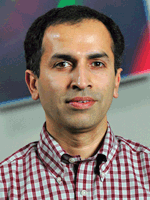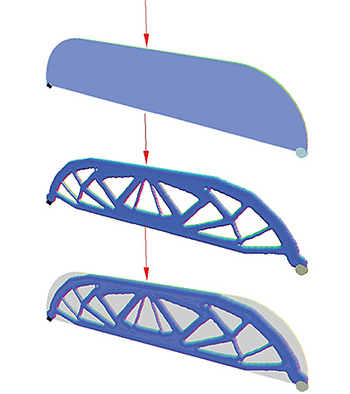Souped-up software reduces guesswork, tedium in computer-aided engineering
A team of University of Wisconsin–Madison engineers recently released a new computer-aided engineering software program, and its users are already calling it a “gift from heaven.”
UW-Madison mechanical engineering Professor Krishnan Suresh led a team that spent four years developing the software, which assists in optimizing the design of parts for just about anything — from bicycles and airplanes to bridges and furniture.

Krishnan Suresh
The software is intended to help designers quickly identify component shapes — known as topologies — that maintain their structural integrity while using the least amount of material possible. Less material means components are both cheaper to produce and weigh less, major goals of most design engineers across applications.
“Design optimization lies at the heart of modern engineering,” Suresh says. “It is critical in reducing cost, reducing material, reducing weight and increasing quality, and is a driving force behind innovation.”
The free software is available as a plug-in for the popular computer-aided design program SolidWorks and as a cloud-based program accessible over the Web. The SolidWorks plug-in, called ParetoWorks, has been available since 2013, and is used by more than 50 universities around the world as well as several industrial corporations. The Web-based version, released this year at cloudtopopt.com, already counts more than 500 users, with two or three new users each day, Suresh says.
“We’ve been getting a lot of positive feedback,” Suresh says.

The series of graphics above show a hypothetical structural problem: the component must hold up under the stress of an applied force, represented by the arrows. The top image represents the component before optimization, while the following images show the component optimized by Krishnan Suresh’s software. Credit: Krishnan Suresh
According to Suresh, the software is popular because it not only takes the guesswork out of creating ideal component topologies — a feature already available on other commercial software tools — but does so at incredibly fast speeds. The software needs only seconds to identify an optimized shape for a component, which Suresh says is far and away faster than other available software, all of which is beyond most human capabilities.
“Design optimization can be very tricky, and difficult for humans to carry out manually,” Suresh says.
Even an exceptionally talented human engineer cannot intuitively come up with some of the material-saving topologies that a robust computer program is able to identify.
“We believe our tools are more robust, have wider applicability and are significantly faster than competing software and human design,” Suresh says.
The innovative software was largely funded by the National Science Foundation, and more recently by Sandia National Laboratories and the software company Autodesk.
The software assists in optimizing the design of parts for just about anything — from bicycles and airplanes to bridges and furniture.
Suresh says the next goal is commercialization. His team is partnered with Jon Eckhardt, a professor at the Wisconsin School of Business and the executive director of the Weinert Center for Entrepreneurship at UW–Madison, and their goal is to create a spinoff company.
Suresh says the possibilities for commercialization are bright, as designers in all sorts of fields could benefit from the software. For instance, designers in the 3-D printing industry are quickly adopting the software because it helps reduce expensive printing materials.
Suresh has worked with companies such as Madison-based Design Concepts to continuously improve the product.
“They helped flush out a lot of problems with the software in its early stages,” Suresh says.
Now, the software is sufficiently robust and user-friendly to take to the masses — a major milestone in the world of design optimization.
“To the best of our knowledge, this is the first implementation of a full-fledged 3-D cloud-based design optimization,” Suresh says. “It’s an accomplishment that even large corporations are struggling to match.”
—Will Cushman
Tags: computers, engineering, materials, research




